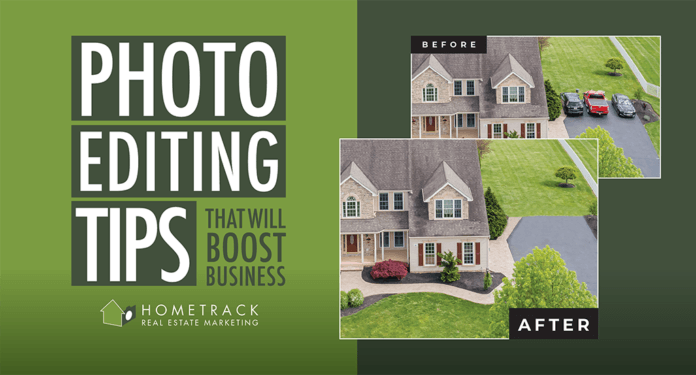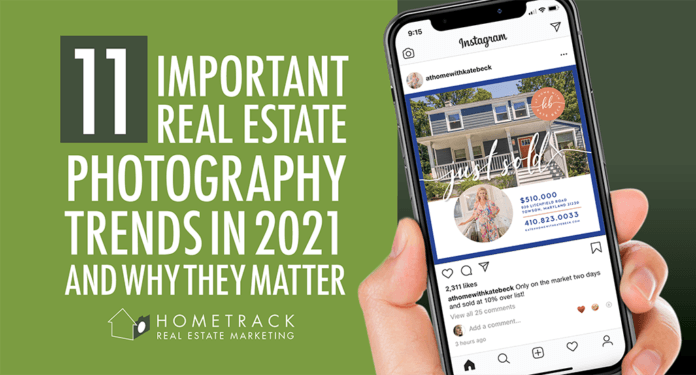REAL ESTATE PHOTOGRAPHY
Our Blog For Mastering the Art of Real Estate Photography

HDR vs FLASH
Both HDR and flash have their uses. And both can help you to capture higher-quality photographs. But neither option is perfect in every situation. Variables such as the amount of natural light available, budget for a project, and time allotted for a photo shoot and editing all factor into a decision between HDR and flash photography.

Photo editing is the post-production process of digitally altering or enhancing a picture using special software. Once a photo shoot has taken place, the work of editing begins in order to ensure that the images representing a home are of the highest quality. Any agent who wants their real estate business to stand out in a crowd knows that important details cannot be ignored. That is especially true when it comes to real estate photography . A picture is what first draws the attention of the more than ninety percent of people who begin their home searches online. And pictures are what keep their attention the longest. Those agents who pay attention to the details and provide their customers with premium pictures are able to set themselves apart as a premium business. And yet, not every photograph is a work of art. Ask any teenager who snaps dozens of selfies to find the perfect shot to post online. Truth is, even professional photographers take dozens or even hundreds of photographs during a photo shoot and cull the very best photos from the batch. But they do not stop there. Once the best photos have been selected, the hard work of editing serves to enhance those images. The color may need correction. The light may need to be balanced or the exposure adjusted. These and a host of other alterations are employed to help a home to look its best. (Read also about “ What Goes Into Video Editing ”) Beyond some of the more standard edits, a photographer or photo editor may also perform more advanced modifications, such as object removal to get rid of unwanted items in an image, or blue sky replacement to make up for a shoot that took place on a cloudy day. From simple resizing to full-blown virtual staging , a professional photography service can offer up the highest quality photographs for your customers’ listings. Of course, you may choose not to seek the services of a professional photographer. You may prefer to take pictures yourself. Either way, it is critical that the pictures you provide your customers be first rate. And that means not only taking great pictures – and plenty of them – but careful editing to boot. So, what editing tools and tricks should you use with your real estate photos ? Well, that all depends on what your photos need and what your clients request. Here are some of the more common photo editing elements along with a few advanced services you can employ. Cropping and Resizing. Photos that are taken at a distance often leave the subject looking small or insignificant in the background. Narrowing down the field of view can help to focus a viewer’s attention on what matters. Color Correction. Raw images taken of a room or a yard often appear dull or drab. Or the colors captured by the camera just don’t look quite right. Maybe the blues look too much like purple, or the whites came out a little too white. Color correction adjusts the color in a photo to make it look as accurate as possible. Light correction. White balance is the process of removing unrealistic colors cast on objects or walls to make sure that what appears white in real life renders as white in your photos. Other lighting corrections can change the contrast, deepen the shadows, add highlights, and more. Straighten Lines. When horizontal lines in a picture are not level with the horizon and the vertical ones are not straight up and down, the whole image seems distorted. Sloppy. Unprofessional. Fortunately, the lines in an image can be corrected to align with a grid so that the picture appears straight and true. Object Removal. Sometimes an object makes its way into a photo unintentionally. A lamp cord sticking out from under an end table. A cup left on the counter. Other times, personal information or images are captured in a picture, such as family portraits, framed diplomas, or computer screens. These unwanted items can be removed during the editing phase. Blue Sky Replacement. Photo shoots cannot always be scheduled for perfectly sunny days. Good news is, a grey sky can be replaced with a blue one by a photo editor. The background of exterior shots can have a blue sky added to them. So can the views through the windows from inside a home. A similar process can be used to make the lawn appear greener or improve the reflection in the water of the backyard pool. Twilight Conversion. There is something altogether captivating about an image of a home set against the eerie backdrop of a sky at dusk. It is a little dark, dramatic, and a bit extraordinary. Photographing a home during the “golden hour”, the period of time just before sunrise or just after dark, requires precise timing and near-perfect conditions. Virtual twilight conversion does not. An ordinary picture can be converted to have the same appeal. Virtual Staging. Staging is an effective way to showcase a home at its best. An empty home is often slow to sell; a disheveled one even moreso. But physical staging is time consuming and expensive. Virtual staging, on the other hand, can transform an empty (or nearly empty) home into a fully-furnished and professionally-staged model in nearly any decorating style – at a fraction of the cost. While this is not an exhaustive list of photo editing options, it does emphasize the range of opportunities (and responsibilities) to make your clients’ photographs the best they can be. And not just that; the better the quality of your photos, the better your brand identity . Your customers – and anyone else who views your listings or visits your website – will judge the quality of your business by the quality of the photos that represent your product. Those images reflect how hard you work to sell a home. Once upon a time, curb appeal was king. While that is still true to some extent, the way that people see a home from the curb is mainly through a photograph. Whether those pictures are uploaded to the listing, posted to social media , or featured in your postcards or brochures , your customers expect a professional product, regardless of who snaps the shutter. And while excellence begins behind the lens, it ends with professional photo editing.

Any agent can benefit from a partnership with a photo editing service for real estate photos . It really doesn’t matter if you tend to contract a photography service , or if you prefer to take pictures yourself. Handing off the job to a professional photo editing service, whether that is a simple touch-up on a batch of photos or a full-scale virtual staging , just makes sense. The truth is, you probably know that already. After all, there are certain responsibilities in the process of listing and selling a home that you would probably not consider to be yours. You might coordinate most of the items that need to get done, but you don’t process the mortgage, perform the title search, or facilitate the closing. You don’t dig up the septic tank or test for mold in the basement. Those responsibilities naturally fall at the feet of other professionals. And yet, when it comes to a task like photo editing, many agents feel like they simply cannot sublet the responsibility of photo editing to someone else. “I can’t afford it,” they say. “I don’t want to give up that much control.” Or, “What would people think?” What is included in a professional photo editing service? Most people understand that photo editing is a process of altering a digital image after it has already been taken, during the post production phase of photography. Really, almost anyone with a mobile phone is aware that photos can be edited after the fact using an on-board app. For serious editing, though, digital image files are uploaded into editing software, such as Adobe Photoshop or Lightroom, where they can be cropped, adjusted, and altered. But those editing features are merely the beginning of what is possible in post production. Lighting, color balance, and other image modifications are included, yes, but so are advanced services. Here are some examples of the types of edits that might be done to real estate photographs : Basic photo editing. This can include anything from adjusting contrast, exposure, lens correction, color adjustment, resizing and cropping, and more. Object removal. Any unwanted items that were missed when preparing for a photo shoot, like a wayward sock on the bedroom floor or a cat that took an untimely walk in the background, can be erased from a photo. Virtual staging. Vacant homes have a tendency to sit too long on the market. And yet, traditional staging is costly and not always feasible. A home can be virtually staged after it has been photographed using this editing service. Twilight conversion. There is something stunning about a home photographed at the “golden hour” just before sunrise or after sunset. But that “hour” is only about fifteen minutes long – not too convenient for every photo shoot. Twilight conversion can take a regular photograph and make it look like it was taken at dawn or dusk. Blue sky replacement. As with twilight conversion, this service makes up for less-than-ideal conditions when capturing images of a home or property. A dull and cloudy day can be turned into a bright and cheery one with blue sky replacement . Green Grass. If the sky can be turned blue, why not green up the grass at the same time? Some of these services come standard when you send you photos to be edited. Others are add-on products to help you showcase your properties. Photo-editing myths Clearly, there are many things that can be done to enhance the images for your listings. Still, many agents choose to go it alone when it comes to photo editing. Why? Probably because they believe things that are not true about the service. For instance, some people believe that it costs too much to send out pictures for editing. Nothing could be further from the truth. Think about it. Photography takes time. Time to declutter. Time to prepare the kitchen and other parts of the house to make them photo-ready. Time to take the pictures. But the most time-consuming part of the process is post production. Editing. After everything else is done, someone has to sit at a computer and make ready the pictures for publication. If you, the agent, are the one sitting for long hours at the computer, you are not doing the one thing that actually generates revenue for your business: selling homes . It is like a commercial fisherman who finds himself cleaning, processing, packing, and shipping his own fish. All of those chores done on the land take away from his time on the water where he actually catches fish. That is where his time is best spent – in the boat, not on dry ground. Is it not the same for an agent? Your time is best spent building and nurturing relationships with people, not with a software program. Another myth that agents fall to is that they will lose control of the process if they hand it over to someone else. But is it really true? In order to “be in control” of the editing process, you need to have a thorough understanding and knack with each of the editing tools and techniques available. That takes more time and more money. Handing off your photos to a professional editing service does not mean that you give up editorial say in the process, only that you do not need to be the expert of all things editing. Not to mention, the turnaround time for a professional editor is probably a lot faster than what you can do anyways. Leave the photo editing to the professionals. Finally, some agents want to project that they are in control of every operation, and so the idea of outsourcing is perhaps a bit unpalatable. What would your clients think if they knew you were sending their photographs out to an outside business? Actually, they would probably be comforted. As long as you frame the discussion the right way, your clients will appreciate that you are providing the best service possible for their home. Remember, a professional photographer or photo editor understands not only the technical process to achieve an adjustment to a photograph, but also possesses the artistic ability to make it look natural. Remarkable. Professional. Benefits of professional editing Besides the fact that you can trust your photos to a professional photographer or editor who knows his or her craft, there are other benefits to professional editing. Better your photos. Since photos are the number one draw for a property – that makes them pretty important – the higher their quality, the better your sales Build your brand. Your photographs will also be a hallmark of your business. Again, the better their quality, the better the perception people will have of your business brand. Increase your credibility. Many listing photos reveal that agents across the country do not place the importance on photography that they should. Poorly framed and lighted cell phone pics do not lend a sense of credibility to a business. Professionally edited photos do. Re-purpose and multi-purpose your photos. Today, your listing photos need to do more than accompany the listing. You should be able to include them in your social media posts, on your website, and in your postcards or brochures. A professional editing service can optimize your digital photos for each platform – and for viewing on mobile devices. With these benefits and more, it should be clear that, whether you take your own pictures or hire a pro, the job of editing those photos should be left to a professional editing service to save you time and money.

What is Blue Sky Replacement? Sky replacement is a photo editing process using digital tools to alter or replace the sky background in a picture during the post-production phase. It is often used to enhance real estate photographs that were shot in less-than-ideal conditions. Why replace the sky? The late Ella Fitzgerald sang, “Blue skies smiling at me. Nothing but blue skies do I see.” Those are fanciful words for sure, but they certainly do not ring true in the world of real estate photography , where a photo shoot often needs to be completed when the sun is in hiding and the skies are dull with clouds. And yet, image quality is one of the most important factors that leads to customer engagement with a property listing, social media post, or web page. In the highly competitive world of real estate, where nearly ninety percent of homebuyers who search online place photos at the top of the list of useful features on a listing website, it is essential to present not only the highest quality, but the most compelling images possible. After all, viewers spend only about twenty percent of their time reading your property descriptions – and about sixty percent of their time viewing your real estate photos . What’s more, studies show that seventy percent of agents believe high-quality photography helps them to win more listings and improve their business brand . Plus, those photos garner sixty-one percent more views online and help homes to sell faster. And yet, even the most competent photographer using the most sophisticated photography equipment cannot control every condition during a photo shoot. A perfect picture is not always possible. That is where photo editing comes into play. A Blue sky replacement service can enhance your photographs after the fact, when conditions were not ideal during a photo shoot. What is involved in blue sky replacement? As you probably know, post production and editing take place after a photo shoot has been completed. Digital files are uploaded into editing software where they can be cropped, adjusted, and altered. Like twilight conversion or virtual staging , a blue sky background is one of the services provided by professional real estate photographers and editors. Blue sky replacement can be done to both outdoor and indoor images where the sky can be seen through the windows. To perform the service, a photo editor will select the sky background section of a photo and swap it out for a vibrant and cheery blue alternative. But the editing does not end there. To make sure the altered photo looks natural, the rest of the image must be enhanced to blend with its new horizon. For instance, an editor must pay careful attention to highlights and shadows, or to the color effect that a brighter and bluer sky might have on objects in the photo. A background that is too bold or saturated, or one that includes colors that are inconsistent with the rest of the picture can look fake and unrefined. Likewise, if an editor fails to consider where the light falls on trees and buildings and other structures, a picture can appear unnatural. Photo editing is as much an art as it is a science – and that includes sky replacement. Blue sky replacement photographers and photo editors develop a keen eye, a sense for composition and color in a picture. An understanding of how light affects a subject. That holds true when framing an image through the camera lens and when enhancing that image on a computer screen. Why hire a professional for blue sky replacement? In today’s technological world, there are advances made almost every week. New cameras . New mobile devices . New software packages. Open houses are now online and real e state videos are taken from flying drones . Not only are the tools getting better and smarter, they are getting cheaper. If there is a downside to the advances in technology and the decreases in cost, it may well be that there are a good many people, agents included, who are attempting to perform “professional” services without professional skills – or results. Sure, some agents are skilled photographers and editors . But that is not the majority of agents. The evidence for that can clearly be seen in the plethora of poorly framed, lighted, executed, and edited pictures that accompany property listings on the MLS. Many agents would be better served if they considered professional photography for their customers. And while some agents undoubtedly possess the skills to take care of their own photography (some might also have a staff photographer in house), the sheer amount of time it takes to set up a photo shoot, assemble the tools, take the pictures, and do all of the editing (including sky replacement) can take a serious bite out of the time left for other responsibilities. Interestingly enough, most agents agree. According to one study, more than nine out of ten agents are passionate about the importance of using professional photography, and yet only half actually do so for all of their listings, and fifteen percent do not hire a professional photographer at all. And yet, those agents who rely solely on professional photography tend to earn higher commissions. And those who have the finest images available for their clients boost their brand identity to boot. A professional photographer will take hundreds of photographs, cull them down to a select series of shots, edit them according to your conditions, and make them available to you in short order – usually within 24 hours. Professional photographers and editors have a faster turnaround time for a finer product. Blue sky and all. So, handing off photography responsibilities to a professional service can not only free up time, but it can offer a good return on investment. Photography services are remarkably affordable, with packages starting below two hundred dollars. The main goal of blue sky replacement and other professional editing features is to attract buyers to your listings, your print ads (like postcards and brochures ), and your website. Unless your pictures pop with vibrant color and vivid detail, and yet with a natural look, they will not have the impact that you desire and your sellers deserve. So, maybe Ella had it right: “Blue days, all of them gone. Nothing but blue skies from now on…”

Exceptional real estate photography is an essential component of any healthy real estate marketing campaign. After all, high quality photos help to sell homes faster and at higher prices . They attract more buyers and keep them engaged for longer periods of time. And top notch photography helps you to build your brand . Think about it. Photography runs through nearly every aspect of your marketing arsenal. Consider the most popular tools used by agents. Which of the following do you rely on regularly? Social media Email marketing Direct mail Listing videos Print ads 3D tours It is likely that you wield most if not all of these weapons in your marketing campaigns. What do they each have in common? Photography. Elevate the quality level of your photography and you automatically raise the bar for your entire marketing effort. With that thought in mind, consider these 11 trends in real estate photography and how they might impact your customers and your business. Online searches. Nearly all homebuyers today begin their home searches online, and most of them find photos to be highly useful. In fact, stunning imagery is the number one feature that grabs and holds their attention. Not only do quality photographs attract potential buyers, they keep them on the page longer, especially if there is an ample supply. Social media. In today’s market, the influence of social media cannot be overlooked. Forbes suggests that social media is “the biggest factor in the new real estate market.” And why not? Many buyers will search on social media for homes that match their preferences, using hashtags to help them find all the little niches in which they are interested. Mobile devices. Nearly three quarters of buyers use a mobile device – a cell phone or tablet – to search for properties online. That fact makes it important to ensure that your photographs are mobile-friendly, that they are optimized for the technology. Professional photography. In a hurried world, where there are far more responsibilities than hours in a day, many real estate agents are turning to professional photography services. That way, an agent can focus on cultivating leads and building relationships rather than on trying to figure out which photographs to get right and then spending hours editing for print and digital publication. Editing services. Of course, there are plenty of agents who prefer to take their own photos. Some are quite skilled. But snapping the pictures is not the end of the job. For a photo shoot to be successful – and professional – a considerable amount of time with tedious editing is still necessary. So, for those agents who have a knack with a camera, subletting that process to a professional photo editing service is a solid option. Virtual staging. Putting together a photo shoot begins long before the lens cap is removed from the camera. Time spent cleaning up the clutter, setting up a living room, or preparing a kitchen for photography gives the lens something worth capturing. Even better, home staging can put a set of images over the top. But time and budget does not always allow for staging. That is where virtual staging comes in handy, where an image of a relatively empty room can be digitally rearranged to appear fully furnished. Image enhancement. Sometimes a shoot does not go entirely according to plan. A stray sock is left on the floor. A mark goes undetected until it is too late. Or the sun simply refuses to come out when it is time to take the pictures. Image enhancements can allow images to be altered after the fact to accomplish anything from removing a scuff mark to creating a blue sky in the background to augmenting the view through a window. Twilight photography. Another emerging trend in real estate is giving some listings a boost. Photos shot during the “golden hour” (also known as Twilight photography ) shortly after sunrise or just before sunset can yield stunning images of outdoor spaces, waterfront views, landscapes, city skylines, and more. Drones. Videography from a bird’s eye view can capture the imagination of home buyers as much as any marketing tool. More and more agents are finding that they can not only use drone footage to feature a property, but also to highlight area attractions, update buyers on the progress of their new construction project, check out the condition of the roof and other property details that are not accessible from the ground. Walk-through videos. People love a good story. It is no wonder that three hundred hours of video are uploaded to YouTube every minute and five billion videos are viewed every day! Real estate videos allow an agent to tell a story while highlighting a home – or the route to the neighborhood elementary school, coffee shop, or other attraction. 3D virtual tours. Agents are learning that homes sell faster and often at higher prices when their listings come with 3D t ours . Although the technology has been trending upward for years, services like Matterport have become the new open house in the wake of the COVID-19 pandemic. Absent from the list, though by no means of any less importance, are print advertising products, such as postcards or brochures . Those simply do not diminish in significance as part of your marketing mix. And quality print ads have always necessitated quality photographs. So, as you can see and are likely aware, exceptional photography lies at the core of nearly every marketing move you make. Agents who are unable or uninterested in producing the best photo images possible will find it far more difficult to compete – and to service their clients with excellence. Moreover, every real estate marketing strategy that is touched by photography will suffer if the photography itself is not sound. Fortunately, it is easier than ever to achieve excellent results. The potential for quality photography has risen in recent years with advances in digital technology. Even the iPhon e in your pocket is a powerful photographic device when wielded properly. Likewise, a host of creative applications within real estate photography has made it possible to appeal to a wide audience. Whether you choose to take your own pictures or contract with a professional real estate photography service , remember that the quality of your product across all of these trending topics will be a hallmark of your business and a key to your success.

Like a glacier, COVID-19 is carving its way across the country and around the world, reshaping the landscape as it goes and leaving behind a new way of life. The world of real estate is not immune. It happens every so often, you know. Something comes along that redirects the course of history. We are in the midst of one such event. Like the citizens of the world a hundred years ago during another pandemic – or a depression, or a world war – we are experiencing a seismic shift in what we have known to be normal. So, what are businesses doing to remain alive and relevant through the coronavirus pandemic and beyond? What kinds of strategies can real estate agents take advantage of when in-person transactions are fewer and further between? And, maybe most importantly, what are some underlying principles that can lead to a successful real estate marketing model in the days to come? A metamorphosis of sorts For nearly a year, agents have adapted to the coronavirus out of necessity. Shutdowns and stay-at-home orders have all but eliminated face-to-face interactions. At least that has been the case for long stretches of time. And with COVID-19 and its variants still making rounds (and vaccines slow to follow), many buyers and sellers are reluctant to go back to business as usual. So, meetings with clients have gone virtual with tools like Zoom and Google Meet . Showings have gone virtual too, with 3D home tours becoming an almost expected offering. What a difference a matter of months can make. Emerging marketing trends were already in motion even before coronavirus became a household word. The uptick in out of town buyers and the preference of many young (and not-so-young) clients for digital media has been driving the industry toward online and digital solutions for years. The same is true for other technologies. Drone photography , HDR imaging, and even virtual staging . Each solution was making its mark on real estate prior to the health crisis. So were social media and video marketing . It’s just that the pandemic made these strategies necessary for survival. But not everything now is new. Interestingly, tried and true “old school” marketing strategies, like photography and real estate videos , are as relevant today as ever. Take print advertisements. Certainly they have a place in today’s marketing mix – even in a digital world, especially in a world of people who are staying at home. Print advertisements separate your message from a crowd of voices in a hyper-digitized world. More than that, they leave a lasting impression on your clients, provide a broader customer experience for the majority of customers who prefer the tactile sensation of printed paper, and are perceived as a more trustworthy source of information than online ads. So perhaps, like the Monarch whose shape is altered to something altogether new and yet in essence is made up of the same stuff it started with, the metamorphosis of the real estate market is more about the principles that undergird our decisions and our strategies than they are about the specific tools we choose to use. Stories from other industries Every industry has its challenges navigating the changing landscape. Take commercial airlines for instance. With travel restrictions and advisories in place all over the world, passenger flights have been at their lowest level in decades. To make up the difference after cancelling ninety percent of their scheduled flights, some airlines have begun to offer cargo flights to transport groceries, medical supplies, and all of the extra shipments necessary while people are ordering goods online. Hotels, too, are experiencing an unprecedented drop in bookings. One solution has been to give much-needed space to people who have been working remotely from home. For a reasonable price, remote workers can have access to a quiet room equipped with high-speed internet access for use as private office space. A “home-away-from-home office”. Grocery stores, pet supply stores, auto parts stores, and just about any other type of stores you can think of are thinking outside the box. Or rather, outside the building. Restaurants offer take-out and outdoor dining complete with geodesic domes to maintain social distancing. Retailers are offering curbside pickup. Some stores have even “gone dark”; they shutter their indoor operation in favor of curbside-only service. Whether it is a grocer who offers home delivery, a fitness company that has shifted to online workouts, or an office where all of the personnel check in from home each day, businesses have had to change how they operate in order to operate at all. Real estate enhancement opportunities When it comes to real estate marketing, you are likely aware of the tools available to you. Perhaps you have implemented some of these tools for your clients. Or maybe you have not taken the plunge on some of them. The changing topography of the industry is making it necessary to change and grow – or else grow irrelevant. Consider these opportunities that many agents have adopted: Virtual tours . The first and probably the most obvious strategy is the use of 3D technology, such as the Matterport virtual showcase that offers a “ digital twin ” of any space, indoors or out, that buyers can visit on any device, on their own time, and in their own homes. Matterport is even compatible with virtual reality devices for an enhanced experience. Enhanced photography. Not only is 3D imaging available, but today’s photography is captured with high-definition, High Dynamic Range (HDR) cameras and edited by experts. Add aerial or drone footage and twilight photography to the list of services that you offer to your clients. Viral video . Real estate videos are not new. But new technology allows an agent to create meaningful videos that work with any budget. You can contract with a professional videographer for storyline or home tour videos on your higher end listings, or you can shoot relaxed “impromptu” testimonials and walk-throughs with your cell phone. Some agents have even found that their videos have gone viral. Social media. Social media is rife with sensationalism these days. The pandemic has not helped in that regard. But you can also get a lot of miles from keeping in touch with your current client list and your previous customers via social media channels. It is also a great way to share your virtual tours, videos, and listing photographs. Website design. The most likely place to house all of your marketing media – an “about me” page with a video introducing you as an agent, client testimonials, links to your listings, photos, tours, and more – is your business website. Brand recognition. Running throughout all of your marketing efforts should be a clean and consistent business brand identity. That includes the look and feel of your communications. Color scheme, font choice, writing style, logo. These all are part of a professional business brand that communicates what your business is all about before you make your first personal introduction. Email. Still the most widely used form of communication – and cost-effective at that – email reaches large numbers of people in the shortest amount of time. Send individualized open house invitations, new listing announcements, holiday greetings, and more through custom email blasts . Direct mail. Whether postcards or brochures , direct mail remains relevant at a time when meeting face to face is not an option. Actually, it is said to outperform digital channels significantly. Guiding principles No matter what marketing strategies you choose to employ, new or old, they are really less-than-optimum if you do not have a cohesive set of principles to undergird their use. Why are you doing what you are doing? How is what you offer different than the agent down the street or around the corner? What makes you unique and how will you uniquely offer solutions for your clients? Where is your place in the market? Here are a few concepts to consider. Creative approaches that businesses have taken to set themselves apart. When you read each one, ponder how you might come up with a creative use of the tools at your disposal for your clients. Create your niche. One challenge you likely face is getting your message to stand out in a crowded market. E-commerce company Bonobos is among a number of businesses who, unable to compete with the likes of Amazon and eBay, have chosen to narrow their focus to a select group of customers. A target audience. A niche. They focus on getting one thing right: selling mens pants that fit. You might become the area expert in office, industrial, or medical spaces. Specialize in bankruptcies or short-term rentals. Conquer the neighborhood as the go-to agent for Air bnbs. Customer experience. Bonobos also decided to excel at customer service; so did Warby Parker, the online discount eyewear retailer who have harnessed the power of story to connect with their customers and engage them in the buying experience. How might you engage in service to your clients in a way that ensures you are the only agent they think of when it is time to buy or sell a property – or tell their friends? Create a community outreach campaign. TOMS has developed a rapport with their customers by making them feel good about buying shoes. Their strategy involves not only engaging their audience, but providing a positive social mission in which customers can participate. For every transaction, TOMS’ “One for One” campaign donates a good or service to underserved communities around the world. How might you develop a loyal customer base through community involvement and service? Quality. Too many businesses are interested in little else than driving up sales and profits with little concern for their customers or their interests. And consumers are taking notice. ModCloth is a women’s vintage-style fashion retailer decided from its inception that their e-commerce store would be a social experience. Customers are involved at every step of the process: they actively engage through social media, ask past customers to model their products, and involve the community in product design voting campaigns. But underneath every effort is a focus on quality. Anything from photos, blog posts, and listings make shopping with them a fun and engaging experience. Accessibility and authenticity. Providing a quality product is not always enough. You still have to find a way to convince customers that your service is worth its price. One way that apparel retailer Everlane did that is by creating products with radical transparency. They essentially reveal the entire manufacturing process behind their products and illuminate the true costs along the way. That way, consumers understand the quality and the costs attached to it. More and more, buyers and sellers are looking for agents who are accessible and authentic, who prioritize relationships over quick sales and look to the long haul rather than the one-and-done deal. Now that COVID-19 has made its mark on the way business is done, many companies are looking to the future and sorting through how to proceed. Some of the changes we have seen will revert back to the way things were done in the past. In-person showings will once again ramp up, and open houses will likely go live, at least to some degree. But just as some businesses that have sent their employees to work from home during the pandemic will keep them there once restrictions have been lifted, and other businesses that have closed will remain forever closed, some COVID-related real estate practices may go on for a long time. They have been a necessity for now. They will prove to be a benefit for years to come.

2020. A year of challenges, a year of questions, and yet, a year of creative solutions and a focus on what matters most. Along with so many others, real estate agents have adapted to the likes of community shut-downs and business not-as-usual in the wake of the coronavirus. Now, with a very strange year in the rear view mirror, it is time to look forward and take advantage of some of those creative marketing solutions. If you are looking to expand your business, a quick Google search for “real estate marketing tips” will quickly reveal more than two hundred and twenty million pages presumably related to the subject. While you will probably not click beyond the first ten or twenty links, still the sheer amount of information is staggering – and can be overwhelming. How do you plough through all of that data? How do you make sense of it all? And perhaps most importantly, how do you put some of those suggestions into practice?

COVID-19 has changed things. A lot of things. Folks have had to adjust to elbow bumps in place of handshakes. Or smiling with their eyes because the rest of their face is covered with a mask. We tend to avoid crowds, limit the sizes of our gatherings, work remotely rather than commuting to work, and view homes for sale through 3D home tours . Some of the changes are less than desirable, and we hope that they disappear as quickly as they appeared. Too many workers have lost jobs. Too many small businesses are going out of business. There is even talk about “cancelling” Thanksgiving. Or Christmas. But not all of the changes are for the worse. For instance, some jobs that have been performed remotely during the pandemic just might remain that way after it is in the rear view mirror. People are discovering new ways to stay in touch through social media and video conferencing. And digital tools have revolutionized the way business is done. That is especially true in real estate, where drone photography , social media, and 3D virtual tours have changed the way that buyers view a property, sellers show a property, and agents sell a property. Rolling restrictions for in-person property showings due to shutdowns, stay-at-home orders, and safety concerns over potential exposure to the coronavirus , have given rise to the need for – and reliance on – virtual solutions. Matterport , the leaders in spatial data capture and the developers of the “ Digital Twin ” recently teamed up with powerful online real estate brokerage Redfin to explore how the preferences of home buyers and sellers has shifted since the onset of the pandemic. Here are some of the details that they discovered. Better for Buyers At the outset of the pandemic, Matterport surveyed a thousand home buyers and learned that those buyers were no longer satisfied with static 2D photographs of a property and would “overwhelmingly opt” for a more immersive experience . Now, more than seven months into the health crisis, nearly eighty percent of home buyers say that they are choosing to view more properties online with a virtual tour because of safety concerns, according to their new survey with Redfin. But the advantages listed by buyers do not stop there. As important as safety might be, when asked to rank the top benefits of 3D tours , home buyers identified 1) the ability to view the floor plan of a home; 2) the ability to visualize the entire home in Dollhouse view; and 3) the ability to measure rooms, walls, doors, and more. Those were their top three features of a 3D tour. Buyers also indicated that they were more likely to trust the images in a 3D tour over static photos. Seventy eight percent of buyers were concerned that those photographs might be enhanced, “Photoshopped”. On the flip side, they felt that a virtual tour offered a more realistic view of a property – at least eighty two percent of them did (even more sellers felt the same). And that confidence in 3D tours leads many buyers to consider purchasing a property sight-unseen. More than seventy percent suggested that they would do so. That is an increase of sixteen percent since Matterport asked the same question earlier in the pandemic . Better for Sellers Safety was also on the minds of home sellers when they responded to the survey. But that was not always the case. Almost seventy percent of sellers who did not believe 3D tours were necessary before the pandemic now feel that they are. That statistic is even more pronounced in non-urban communities. At a time when it is difficult to schedule in-person showings and, as the New York Times suggested, “the open house is dead”, 3D tours offer an alternative that keeps everyone safer. They also put more of a home in front of more eyes in the marketplace. That includes casting for buyers outside the local market. The pandemic has made it risky for buyers to travel to see listings in other communities or states; 3D tours allow sellers to not only receive remote “visitors”, but also to consider a timely offer in a competitive market. Sellers have picked up on the tendencies of home buyers. Eighty three percent of sellers now think that their home could be purchased sight-unseen (indicating an eleven percent increase in the last several months). Of those sellers who, at the beginning of the pandemic, would not have accepted a remote offer based on a 3D tour alone, sixty four percent would now do so. Top reasons to trust a 3D home tour among sellers? Attracting more serious buyers and selling their homes faster. Safety concerns, although important, took a back seat, as did closing at a higher price. Advantages for Agents If it is true that ninety percent of home buyers begin their journey online, then the first impressions that they have of your listing is essential. That may likely start with high-quality and professional 2D real estate photography , where nearly every searcher’s initial experience with a home is through the first picture you post in the listing. That image gets about twenty seconds worth of consideration. Assuming you grab their attention with that first image, your potential buyers are interested in a realistic representation of the property. To many of them, that equates to a virtual tour. In a market where scheduling in-person tours is a challenge, open houses are few, and online opportunities are many, 3D tours stand out as a virtual open house that can be viewed 24/7, nearly anywhere on the planet. And buyers and sellers have come to expect them. Just ask Redfin, who offers Matterport 3D tours with ninety four percent of their listings. The number of virtual walkthroughs has increased by almost five times on their site since the beginning of the pandemic. 3D virtual tour technology is doing more than filling in for more traditional forms of real estate marketing. It would seem that buyers believe virtual tours are here to stay.

It means a lot to make it to the short list. Whether you are interviewing for a job or a judicial nomination, hoping to win an Academy Award, or developing a vaccine to cure the coronavirus, making it to the short list of candidates is essential. Home buyers sort through dozens or hundreds of listings […]
The post Real Estate Photographs You Need To Get Right appeared first on Hometrack Real Estate Marketing.


